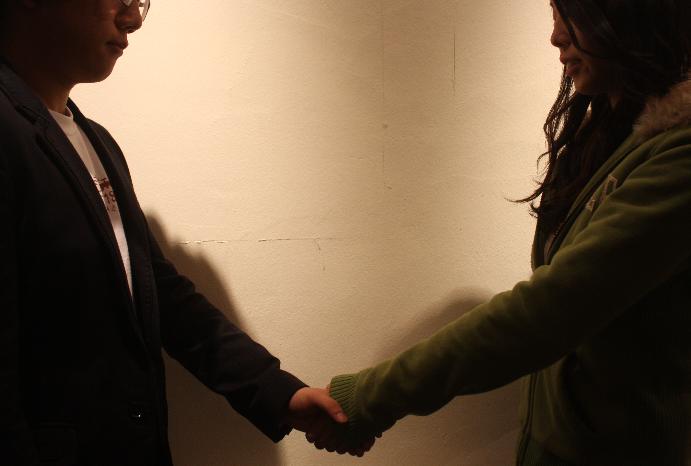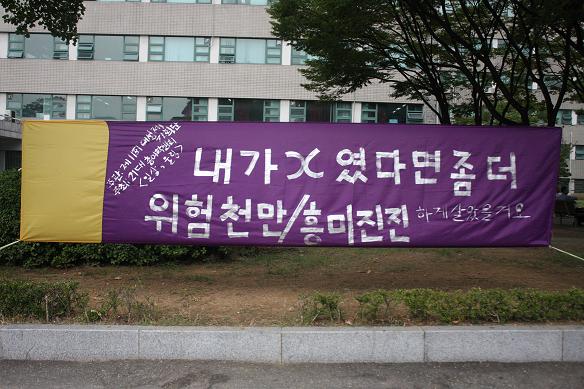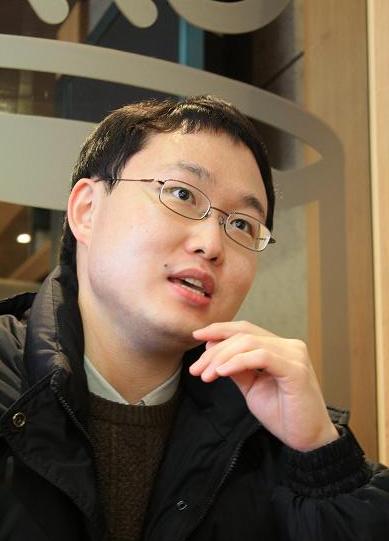1,012 Yonseians’ opinions on gender roles in Korea
Editor's Note
Last month, our campus was bustling with the Student Association (SA) and Women Student Association (WSA) candidates' campaigns. As this is an annual event, many people might not have been taken aback by the fact that at our coed university, there is only a separate student association for the females. Does this indicate that males do not deserve a separate association of their own, or perhaps that the SA is male-oriented? Such gender-equality related questions and issues have been arising not only at our campus, but all over Korea. The Yonsei Annals tried to find out the cause of such discrepencies, and have studied and interviewed much on both feminism and masculism, the two studies on each gender. It is our deepest regret that we could not get the official opinions of the WSA, who had declined our interview requests several times.
Hwang Ji-hyea, Editor of Research Div.
 |
MOST FRESHMEN go through a period of pre-frosh Orientation Time (OT), which introduces them into the society of university. Students participate in the OT before their first semester begins, and get a glimpse of the overall campus life. During the OT, the Women Student Association (WSA) provides a program in which they give a lecture related to sexual violence, and a brief overview of feminism at university, criticizing the male-oriented campus culture. One may nod at parts of the contents, but might still be confused by the campus life that you are joining for the first time. Furthermore, one might wonder why there are no studies defending men’s position, in this era when gender equality is highly valued. An ideology called masculism does exist, however, though most people might not know much about this. The Yonsei Annals had the opportunity to ask 1,012 Yonseians about their thoughts on these two concepts, feminism and masculism.
Box 1: The History of Feminism and Masculism
Feminism (Feminism, Jane Freedman)
- First-wave feminism: a period of feminist activities extended across the later 18th, 19th, and early 20th centuries. In 1792, Mary Wollstonecraft wrote the manifesto, A Vindication of the Rights of Women, which was the basis of feminist theories. It focused as much on fighting social and cultural inequalities as it did on political inequalities.
- Second-wave feminism: a period of feminist activities in the United States beginning in the early 1960’s and lasting through the late 1980’s. This was largely concerned with other issues of equality, such as ending discrimination.
- Third-wave feminism: began in the early 1990’s to address perceived failures of the second wave and also the backlash against movements of the second-wave. It found challenges in what it deemed were the second wave's core definitions of femininity, which overemphasized the experiences of upper middle-class white women.
- The current society: deals with postmodern feminism and other feminisms, which include various aspects of feminism. It challenges the patriarchal society. A number of feminists are active in Korea now, and in Yonsei Univ. lectures associated with feminism, such as Introduction to Feminism take place. (Feminism, Jane Freedman)
Masculism (Masculism and Male Movement to Feminism, Masanori Sasaki and others)
- 1960’s: After the appearance of hippies, the destruction of established male images began in America.
- 1970’s: The organization leading various men’s movements was formalized.
- 1980’s: First lecture about masculism was held in California Univ., about 400 lectures occurred across American Universities. Also, as Japan started to study masculism, masculinists in Japan especially focused on the role of the “Father.”
- 1990’s: After 1993, books about masculism were published in Korea. In addition, the Korean Men’s Association maintained that males are discriminated against and alienated by the anti-women movement.
Yonseians’ thoughts on feminism
Feminism already plays a large role in society. Some people say that they feel the world of women has arrived, and others say that there still exists much discrimination against women. In Yonsei Univ., opinions on feminism and sexual equality are noticeably divergent, especially between men and women. To the question “what impression do you have about feminism?” a total of 53.52% of male Yonseians responded that they have generally a negative impression of feminism, and 44.92% said feminism is an anti-male movement. However, 63.31% of female Yonseians said feminism is essentially sexual equality and 35.25% of them said that they have a positive image of feminism. As seen by the survey, the viewpoints on feminism of men and women are drastically different, depending on gender. However, the degree of acknowledgement of feminism is similar in both genders’ views. A total of 39.65% of the male students responded that they somewhat know about feminism, but do not care about it. Furthermore, nearly half (45.56%) of the female respondents said that they have an interest, but do not know about it well.
On the other hand, many of the students do not put in effort to get to know more about feminism. A total of 26.37% of the men answered that they view media or articles related to feminism two or three times a year, and 37.89% of women also said that. Despite the result that people do not know and care enough for feminism, it is always stressed by many critics when social issues related to women arise, most of which are criticisms.
The current feminism and women’s movements
Although many people might not know exactly what feminism is, there are many forms of women’s movements in the modern world. Since Korean feminism and women’s movements have been established, they have demanded women’s equal rights, and partially achieved success in promoting their vision of gender roles in society. In addition to the WSA, there are small feminist groups and associations. These kinds of clubs, such as Alice, a feminist network which holds study sessions on feminism, are established because women find it hard to speak out in the dongahree or ban activities. Kim Yoo-mi (President, Alice) said that women often face hardships and even easily get isolated from clubs that they belong to. Studies and movements to overcome such difficulties should be acknowledged by people, because they strive for the bright future of feminism and gaining women’s suppressed rights. In spite of this fruitful outcome which feminism has achieved, there are several problems in these movements.
To Yonseians, the most influential organization associated with the women’s movement is the WSA. 40.63% of male students answered that they know only about the WSA, but do not know what they are doing. Even 41.73% of female students said that they only know what WSA does, and do not know their thoughts about inequality in schools. From the survey, it can be inferred that many students do not have much interest in the WSA and related movements on campus. This may appear to be in line with the popularly held view that many young people are ignorant of social issues.
 | ||
| 11th Women Festival at Yonsei Univ. |
Recently, the WSA officially apologized for this year’s women’s festival named “My Name is X,” as it maintained a dichotomy. They insisted that “X” is an alienated gender different from the existing two genders. The festival stressed the idea of alienation too much, perplexing many of its visitors and participants. Although this mistake happened, many of the female movements in the university point out that women in university serve only as dating partners (especially for their beauty). In spite of that, women’s movements seem to overlook something important; there is also discrimination against men.
A takeoff for men’s rights: Masculism
There are some feminists who have fixed stereotypes of men. Some of them argue that they take away the rights of women, so they fight against them. To criticize such offensive feminism, anti-feminist groups came forth. In anti-feminism, there is the idea of both machoism, criticizing feminism itself, and masculism, the most important concept in this movement. This theory, which is less known to the public, talks about men’s rights and discrimination, from which it started. Masculism insists that they admit the problems of women, and that they choose men’s gender identity by themselves. This ideology began in America in the 1970’s, and then spread to Europe and Asia.

Many views of male roles are being debated in the world. In such discussions, many feminists criticize the notion that men are discriminated against, because they argue that men are the ones who harm, not the harmed. However, the masculists think quite differently. Han Ji-hwan, (Member, Korean Masculism Association) says that there is a lethal role given to men. In the patriarchal system, they have to earn money for the family, including women, and if a man is poor, he is treated like an incompetent. Moreover, men even have to be strict to their children as the head of the family. This conception is continued today. It is still a pressure for men to be competent. Even so, they cannot be free from this gender role. Women now think that men should be gentle and have economic ability at the same time.
Especially in the university society, the dominating role of males is evident. A total of 48.24% of male Yonseians responded that compared to females, males are more victimized, as they are expected to be masculine and tough. Moreover, 55.40% of female Yonseians responded that they feel men should always be strong and care for women. The prevailing thought is that male seniors should take care of not only male juniors, but also female juniors. Of course feminists criticize this, because they think men steal rights from women. However, with their excessive rights, men are also handed the burden of responsibility. They are expected to have had many experiences, many abilities to live in society, and spiritual maturity.
Toward the future of genuine sexual equality
Feminism cannot be understood as an alternative to a complete and equal world. Moreover, there are many types of feminism, such as postmodern feminism, racial feminism, and so on. Masculism also has many views regarding women and men. Due to this, various viewpoints of feminism and masculism cannot be simply merged. However, there should be the approval that each other is necessary. Many people have argued that there is no reason for masculism, because they thought of it as simply a kind of anti-feminism based on the question, ‘if there is feminism (which offends men), why is there not masculism (which should defend men)’? On the contrary, masculism started from essential ideas about men. Feminism is also the reason why masculism emerged, because feminism insists there should be future roles for both women and men. Feminism wants to make new roles for fathers and other men. Most Yonseians (Male: 31.84% Female: 36.93%) answered the question, “why do you think masculism exists?” that they thought that masculism began to fight against feminism. However, this is not quite correct. Feminism is only a “basis” of masculism, not a “provocation.”
In reality, few masculinists want to reform men’s power without oppressed responsibility and their gender role. They claim that their statement does not mean there is no need of feminism. The World Economic Forum (WEF) recently announced that Korea ranked 115th among 134 nations in sexual equality this year. There are still many women who suffer due to social prejudices and structures. For example, in regards to many social issues, Kim says that women usually do not discuss the problems they face. To address social problems, feminism should still work to study these problems to empower women. However, feminists should recognize the viewpoints of men and be careful not to be dogmatic.
Masculism and feminism are concepts for each gender. They should recognize and respect each other more. Although each has different views, if they appreciate each other and continue to develop progressive ideas, there could be more social reforms and movement toward genuine sexual equality. As indicated by the survey, we can see surprisingly different viewpoints on these concepts between men and women. If people harmonize their viewpoints, gender equality would no longer be a far-fetched theory. Fortunately, a few leading feminists do sympathize with some masculinists’ views, and they have come recently to admit that parts of masculism are positive.

* * *
As the saying goes, “Each man and woman is prisoner.” It means that among prisoners, each is equal. There may be the difference of grades, but they are still prisoners, and one of them cannot be treated better than another. Similarly, whichever side you take, it does not matter seriously. There are always controversies about the rights of females and males, but advancing to sexual equality is one of the most important issues today. No one should be discriminated against due to their gender. Furthermore, many theories of gender are not mutually exclusive, but intersect when it comes to dealing with genuine sexual equality. Each person should recognize other views, which they do not know well, and try to establish what produces sexual discrimination and the gender roles that everyone has. To rise over the rainbow, feminism and masculism, which are ideas about gender and sexuality, should be acknowledged as equal “partners.”
Spotlight
While researching the contents of feminism and masculism, I found that masculism could not have existed without feminism. Because diverse opinions of women’s rights and roles were constantly discussed throughout history, they formed the basis of the rising ideology of masculism. Reflecting this, it cannot be helped that feminism was mentioned much more in the article than masculism.
Graph 1. Total: 1,012
Sex - Male: 558
Female: 454
Grade - Freshman: 282
Sophomore: 262
Junior: 222
Senior:246
Graph 2. Do you think gender equailty is well ensured on campus?
Men:
too male centered: 1.37%
quite male centered: 25.78%
well ensured: 33.59%
quite female centered: 26.95%
too female centered: 6.25%
do not know: 4.69%
others: 1.17%
Women:
too male centered: 4.80%
quite male centered: 53.96%
well ensured: 29.02%
quite female centered: 4.56%
too female centered: 0.24%
do not know: 6.24%
others: 1.20%
Graph 3. What impressions do you have on feminism? (multiple answer)
Men:
female liberation movement: 31.84%
female supremacy: 34.77%
anti-male movement: 44.92%
sexaul equalitarianism: 35.94%
generally positive: 13.67%
generally negative: 53.52%
do not know: 3.32%
others: 2.54%
Women:
female liberation movement: 45.56%
female supremacy: 14.15%
anti-male movement: 21.58%
sexaul equalitarianism: 63.31%
generally positive: 35.25%
generally negative: 19.90%
do not know: 5.52%
others: 4.32%
Graph 4. Do you know each women's movement on campus and what they exactly do?
Men:
know all women's movement on campus and what they exactly do: 0.98%
know over two women's movement on campus and what they exactly do: 10.16%
know over two women's movement on campus but do not know what they exactly do: 9.18%
know only WSA and what it exactly does: 19.73%
know only WSA but do not know what it exactly does: 40.63%
not interested in women's movement on campus: 11.33%
do not know: 7.62%
others: 0.20%
Women:
know all women's movement on campus and what they exactly do: 1.92%
know over two women's movement on campus and what they exactly do: 14.39%
know over two women's movement on campus but do not know what they exactly do: 16.07%
know only WSA and what it exactly does: 14.63%
know only WSA but do not know what it exactly does: 41.73%
not interested in women's movement on campus: 5.76%
do not know: 4.80%
others: 0.24%
Graph 5. In which aspects do you think women are discriminated against more than men? (multiple answers)
Men:
a grade of rank in organization on campus: 14.06%
atmosphere while drinking: 22.66%
a place as female senior: 14.65%
dress/appearance: 21.68%
sexaul harassment appeared at specific site such as stair: 10.94%
non existent: 47.66%
others: 2.93%
Women:
a grade of rank in organization on campus: 36.21%
atmosphere while drinking: 48.44%
a place as female senior: 32.13%
dress/appearance: 52.52%
sexaul harassment appeared at specific site such as stair: 13.19%
non existent: 14.63%
others: 5.52%
Graph 6. In which aspect do you think men are discriminated against more than women? (multiple answers)
Men:
a grade of rank in organization on campus: 5.08%
atmosphere while drinking: 20.51%
a place as male senior/junior: 34.18%
dress/appearance: 9.38%
character: 48.24%
women's cleaning in men's rest room: 24.61%
non existent: 21.68%
others: 7.42%
Women:
a grade of rank in organization on campus: 5.04%
atmosphere while drinking: 16.55%
a place as male senior/junior: 28.30%
dress/appearance: 3.60%
character: 55.40%
women's cleaning in men's rest room: 17.75%
non existent: 22.54%
others: 5.04%
Graph 7. Why do you think masculism started in Korean society?
Men:
to oppose feminism: 31.84%
there is less authority of male in the general society: 6.64%
insufficient concrete discussion about men: 25.20%
started with sexual equality: 30.08%
incoming from world's trend: 1.95%
others: 3.91%
Women:
to oppose feminism: 36.93%
there is less authority of male in the general society: 6.00%
insufficient concrete discussion about men: 22.30%
started with sexual equality: 28.06%
incoming from world's trend: 3.84%
others: 2.64%

